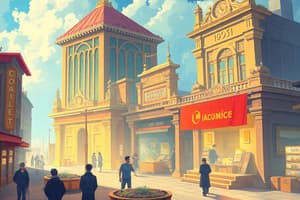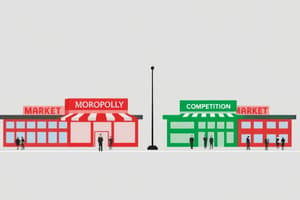Podcast
Questions and Answers
What types of non-price competition are monopolistically competitive firms actively involved in?
What types of non-price competition are monopolistically competitive firms actively involved in?
- Discounts, price matching, exclusive deals, loyalty programs
- Online sales, door-to-door selling, influencer marketing, celebrity endorsements
- Product differentiation, price wars, cost leadership, market segmentation
- Advertising, promotion, free gifts, after-sales service (correct)
What is essential for a new firm entering a monopolistically competitive market?
What is essential for a new firm entering a monopolistically competitive market?
- Innovation and ability to attract consumers (correct)
- Avoiding advertising and promotion
- High pricing strategy and limited product variety
- Barriers to entry and exit
What are the types of profit that a firm in the short run can possibly achieve?
What are the types of profit that a firm in the short run can possibly achieve?
- Economic profit, accounting profit, negative profit
- Variable costs, fixed costs, total costs
- Supernormal profit, normal profit, subnormal profit (correct)
- Monopoly profit, oligopoly profit, perfect competition profit
What types of products did the text mention in the context of non-price competition for monopolistically competitive firms?
What types of products did the text mention in the context of non-price competition for monopolistically competitive firms?
What creates preference among consumers and fosters consumer loyalty in monopolistically competitive markets?
What creates preference among consumers and fosters consumer loyalty in monopolistically competitive markets?
What characterizes the entry of new firms into a monopolistically competitive market?
What characterizes the entry of new firms into a monopolistically competitive market?
Which of the following is a distinct feature of oligopoly?
Which of the following is a distinct feature of oligopoly?
What is the main reason for the existence of barriers to entry in an oligopolistic market?
What is the main reason for the existence of barriers to entry in an oligopolistic market?
Which of the following is NOT a potential barrier to entry in an oligopolistic market?
Which of the following is NOT a potential barrier to entry in an oligopolistic market?
What is price leadership in an oligopolistic market?
What is price leadership in an oligopolistic market?
What is the primary concern for consumers regarding new firms entering an oligopolistic market for products like cars or TVs?
What is the primary concern for consumers regarding new firms entering an oligopolistic market for products like cars or TVs?
Which of the following is a characteristic of an oligopolistic market?
Which of the following is a characteristic of an oligopolistic market?
In a perfectly competitive market, firms earn _____ in the long run.
In a perfectly competitive market, firms earn _____ in the long run.
Which of the following statements about monopolistic competition is true?
Which of the following statements about monopolistic competition is true?
In a monopoly market, a firm's pricing power allows it to earn _____ in the long run.
In a monopoly market, a firm's pricing power allows it to earn _____ in the long run.
Which of the following is NOT a characteristic of monopolistic competition?
Which of the following is NOT a characteristic of monopolistic competition?
In a perfectly competitive market, the equilibrium output of a firm ($Q_c$) is _____ than the equilibrium output of a monopolist ($Q_m$).
In a perfectly competitive market, the equilibrium output of a firm ($Q_c$) is _____ than the equilibrium output of a monopolist ($Q_m$).
Which of the following is an example of a monopolistically competitive market?
Which of the following is an example of a monopolistically competitive market?
Flashcards are hidden until you start studying
Study Notes
Oligopoly
- Firms in an oligopolistic market are interdependent, meaning their decisions on price, output, advertisements, and marketing are influenced by their rivals.
- Price leadership occurs when one firm determines the price and other firms follow.
- Collusion is an agreement among producers to decide the price and output level.
- Barriers to entry include:
- Economies of scale, which allow established firms to lower prices below those of new rivals.
- The need for new firms to introduce their products and attract consumers through advertising, resulting in high production costs.
- The difficulty of providing extensive service networks for products like cars and TVs.
- Consumer loyalty to established brands due to variations in products.
- Non-price competition is used to attract buyers and create brand loyalty, including advertisements, promotions, free gifts, and after-sales service.
Monopolistic Competition
- A monopolistically competitive market has many sellers and buyers, with each firm producing a slightly different product.
- Characteristics of a monopolistically competitive market include:
- Many sellers and buyers, with no individual firm able to influence the market price.
- Close substitutes, with products differing in terms of brand name, quality, label, packaging, and design.
- No barriers to entry or exit, but new firms must be innovative and create a new product that can attract consumers.
- Profit maximization in a monopolistically competitive firm can result in supernormal profit, normal profit, or subnormal profit (loss) in the short run.
- In the long run, the perfectly competitive firm earns only normal profit, while the monopolist earns supernormal profit.
Studying That Suits You
Use AI to generate personalized quizzes and flashcards to suit your learning preferences.




